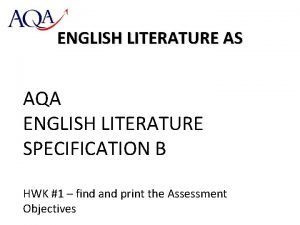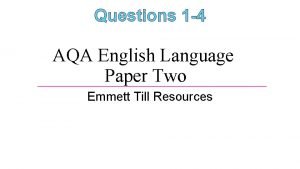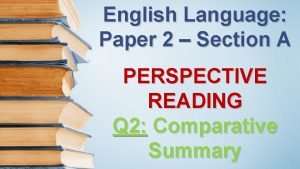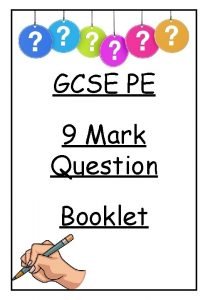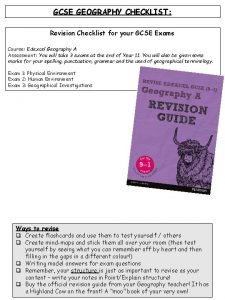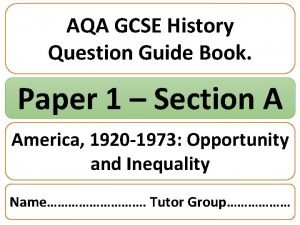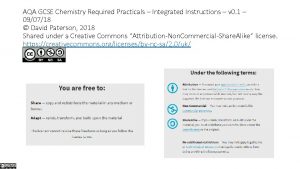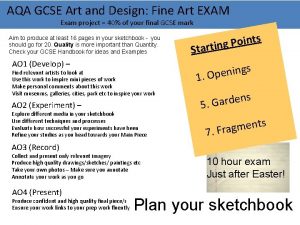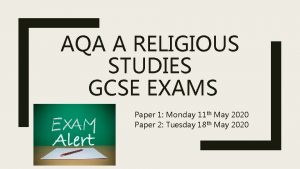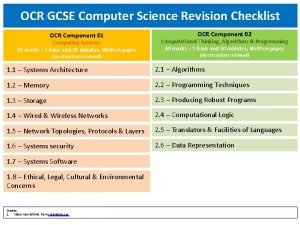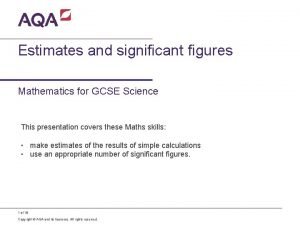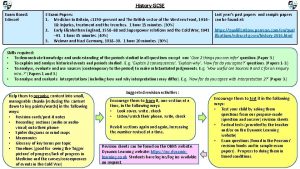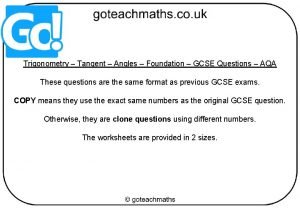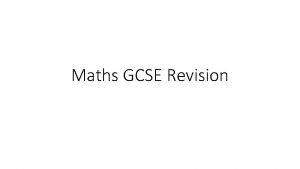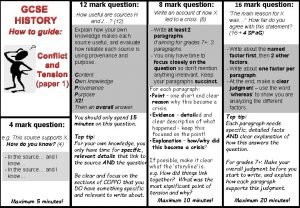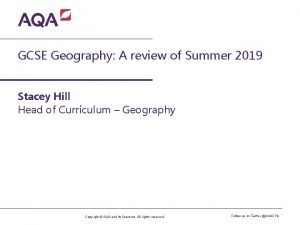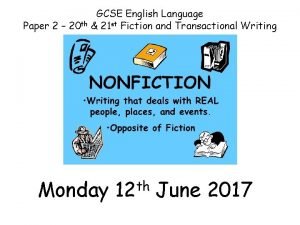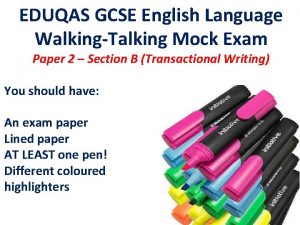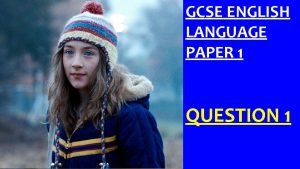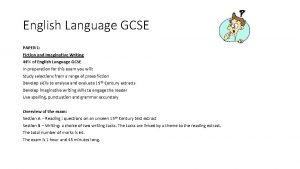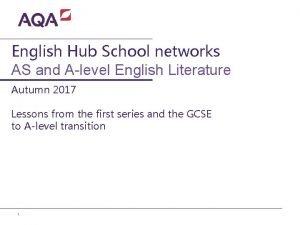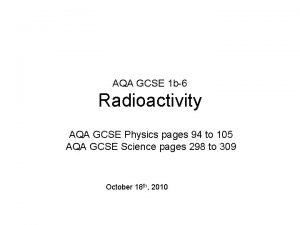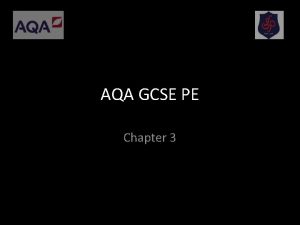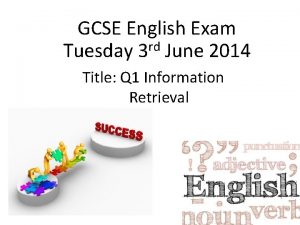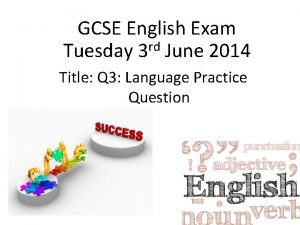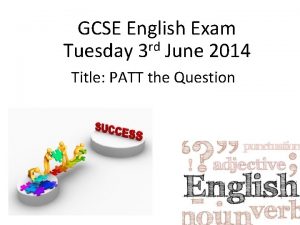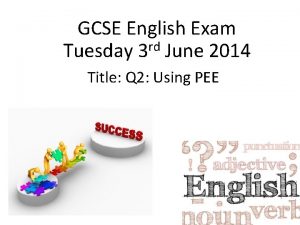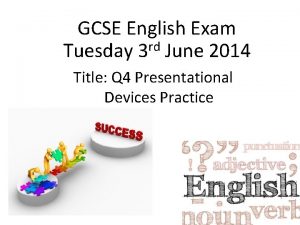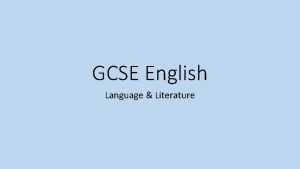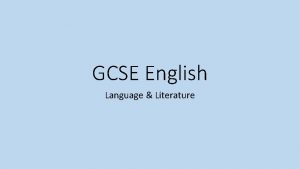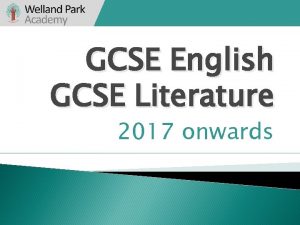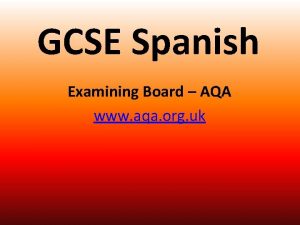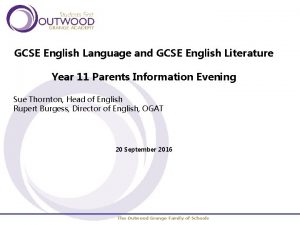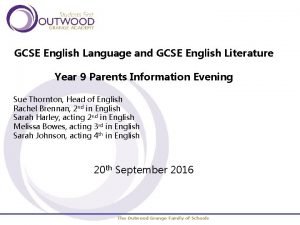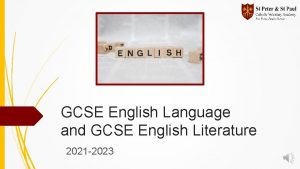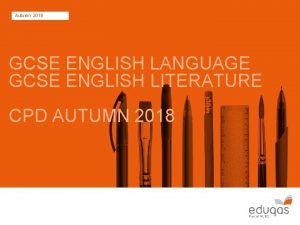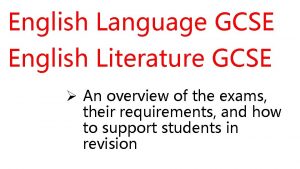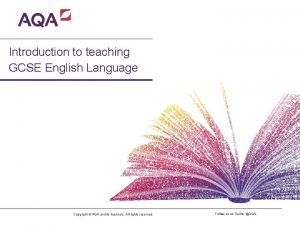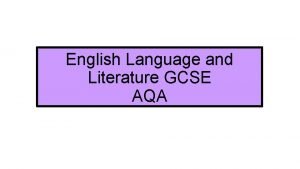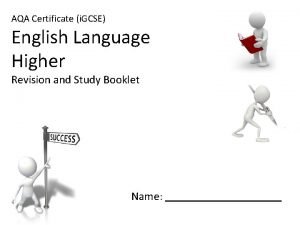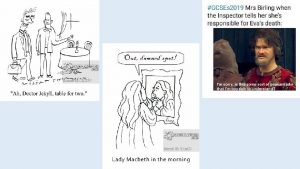AQA A GCSE English English Language Unit 1

























- Slides: 25

AQA (A) GCSE English & English Language Unit 1 GCSE English Exam rd Tuesday 3 June 2014 READING Lesson 1 Title: Q 3: Language Hodder Education Revision Lessons

Revision Objective • To define similes, metaphors and personifications • To explain why writers use them • To demonstrate an effective formula for analysing them Key words: Figurative Literal Metaphor Click to continue

Starter If something is LITERALLY something, what does that mean? E. g. I was literally crying with laughter Click to continue

Literally or figuratively? • As a generalisation, teenagers say ‘literally’ when they mean ‘figuratively’. • E. g. : I was literally dying. • It was literally the worst day of my life • I could have killed him, literally. (although this one could have been accurate - a bit worrying though!) Click to continue

Literal statement § ‘The surface of the lake shone brightly in the midday sun. ’ § This is very descriptive but it is a literal statement because it is wholly factual. No comparison is being made between the original thing (‘the surface of the lake’) and either another thing or a human quality. § Therefore, it cannot be a simile, a metaphor or personification. Click to continue

Figurative Language • • • Metaphor Simile Personification Symbolic Allegory What do these terms mean? Click to continue

Metaphor A metaphor is a comparison in which one thing is said to be something which it literally is not: ‘The surface of the lake was a mirror. ’ or when something is said to be able to do something which it literally cannot do: ‘The lake burned in the midday sun. ’ Click to continue

Simile A simile is a comparison in which one thing is said to be like or as another thing: ‘The surface of the lake was as smooth as a mirror. ’ Click to continue

Personification A personification is a technique by which: § an inanimate (non-living) thing § or other non-human thing § or abstract quality/idea is given human qualities which it literally cannot possess: ‘The surface of the lake glowed with happiness. ’ Click to continue

Symbolic • This is something that is representative of something else. • e. g. It was then that I had a light bulb moment • Here the light bulb is representing an idea. This can also be used to show the importance of an object and what it has come to represent: a motorbike could represent freedom, for example. Click to continue

Allegory • When you use a story to explain a point. • e. g. Jack failed his GCSE last year because he ran out of time and missed out the 24 mark question. • This is used as a way of ‘teaching’ the importance of managing your time. Click to continue

Why writers use them All these techniques can be referred to as figures of speech or imagery. Writers use them to: • create a more vivid (visual) impression of what they are trying to describe • create a favourable or unfavourable impression of what they are trying to describe • create a particular atmosphere/tone which could, for example, be poetic, dramatic, tragic or humorous Click to continue

Your turn • On the next slide are four sentences taken from an extract in which a young man describes his dangerous addiction to motorcycling. • Each sentence is a simile, a metaphor, a personification or a literal statement. Your task is to decide which is which. Click to continue

1. ‘Motorbikes may be a lot more dangerous than cars, but they are still very popular with young men of my age. ’ 2. ‘It may sound melodramatic, but it was as if I was becoming possessed. ’ 3. ‘It filled me with fear and excitement and thrust me into a high-speed world light years away from everyday reality. ’ 4. ‘My dad later told me that he had never really been sure what this obsession with speed was all about. But whatever it was, it had got me where it wanted me. My hands may have been on the grips but its foot was firmly on the pedal. ’ Click to continue

Answers 1. Literal statement 2. Simile 3. Metaphor 4. Personification Click to continue

Example GCSE Question How does the writer use language features in the extract? Remember to: • give some examples of language feature • explain the effects. (12 marks) You could include an analysis of any similes, metaphors and personifications in your answer. Click to continue

So do I just point them out? The point has been provided for you by the question, the evidence can be found in the • You will score very few marks for simply identifying figures text and the explanation comes entirely from of speech and telling the examiner where he/she can find your own intelligence. To help you write an them. effective explanation, you could use the five • To answer the question, you would need to explain how part formula. the writer’s use of these techniques might affect the reader. • To do this, you should use PEE (point, evidence, explanation). Click to continue

The five-part formula 1. Copy out the figure of speech in quotation marks. 2. State which figure of speech it is. 3. State what the original thing being described is. 4. State what it is said to be like/as (simile), or what it is said to be — or said to be able to do — (metaphor), or what human qualities it is said to possess (personification). 5. Find as many impressions as possible which have been created for the reader about the original thing by use of the figure of speech. Click to continue

Example 1. ‘The surface of the lake was a mirror. ’ 2. In this metaphor, 3. the original thing being described is the surface of the lake. 4. The writer is comparing it to a mirror. 5. The impressions created about the surface of the lake by this metaphor are that: the lake is reflective; the lake is very still and calm and, therefore, flat; it is probably a bright and windless day. The metaphor also creates a poetic tone. Click to continue

Read R 6: Second Sight? How does the writer use language features in the extract? Remember to: • give some examples of language feature • explain the effects. (12 marks) You could include an analysis of any similes, metaphors and personifications in your answer. Click to continue

Evidence 1. An example of this writer’s use of figurative language to engage with the reader is… ‘Feeling like Peter Parker after yet another run-in with the fearsome J. Jonah Jameson — except I haven’t got the spidery sixth sense to fall back on…’ Explanation 2. In this… simile, 3. The original thing being described… is the author’s relationship with his aggressive and bullying editor, Gus. Click to continue

4. This is being compared to… the comic book character Peter Parker’s relationship with the equally belligerent J. Jonah Jameson. 5. This image engages the reader because… it is humorous. The simile makes it sound as if this very human and fallible journalist sees himself on a par with the superhero Spider Man. The author then develops this simile into an extended metaphor that runs throughout the rest of the article as he sets up the joke about a ‘super-powered’ octopus (called Paul) which needs to be investigated, thus furthering the parallels between himself and Spider Man. The author’s attraction to a red-haired woman deepens the comic parallel. But what really makes the joke is that the author is clearly no superhero, e. g. his ‘wolfish’ behaviour at the weekends. Click to continue

Example GCSE Question How does the writer use language features in the extract? R 17 and W 34 Remember to: • give some examples of language feature • explain the effects. (12 marks) You could include an analysis of any similes, metaphors and personifications in your answer. Click to continue

Plenary Share your responses with a partner. Add WWW/EBI comments to their work Click to continue

Homework • Do it again! • Read through the article and find another example of figurative language. Following the five part plan, analyse the language used in detail to create a top mark answer. Due next Day 1. Click to continue
 Aqa gcse english literature specification
Aqa gcse english literature specification Aqa english language paper 1
Aqa english language paper 1 English language paper 2 rail disasters mark scheme
English language paper 2 rail disasters mark scheme How to leave the world that worships should
How to leave the world that worships should Gcse pe 9 mark question examples
Gcse pe 9 mark question examples Gcse geography edexcel b revision checklist
Gcse geography edexcel b revision checklist Gcse history 8 mark question structure
Gcse history 8 mark question structure Aqa chemistry gcse required practicals
Aqa chemistry gcse required practicals Aqa a level art and design
Aqa a level art and design Aqa religious studies gcse past papers
Aqa religious studies gcse past papers Anticipating misuse computer science
Anticipating misuse computer science Significant figures gcse
Significant figures gcse Edexcel history gcse past papers
Edexcel history gcse past papers Trigonometry questions gcse aqa
Trigonometry questions gcse aqa Aqa maths gcse revision guide
Aqa maths gcse revision guide How useful questions gcse history
How useful questions gcse history Aqa gcse geography
Aqa gcse geography Edexcel english language
Edexcel english language Edexcel gcse english language paper 2
Edexcel gcse english language paper 2 Edexcel lit paper 2
Edexcel lit paper 2 Eduqas english language component 1 past papers
Eduqas english language component 1 past papers Eduqas gcse english language past papers
Eduqas gcse english language past papers Eduqas narrative writing titles
Eduqas narrative writing titles Language
Language Is english language paper 1 fiction or nonfiction
Is english language paper 1 fiction or nonfiction Aqa english literature nea prohibited texts
Aqa english literature nea prohibited texts
